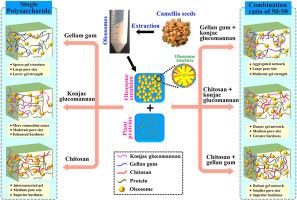Exploring the mechanisms of charged polysaccharides in regulating the microstructure, texture, and rheology of camellia oleosomes-based meat analogs
IF 11
1区 农林科学
Q1 CHEMISTRY, APPLIED
引用次数: 0
Abstract
Plant-based meat analogs produced via the extrusion process still face challenges in replicating the textural attributes of real meat. This study aimed to investigate the effects of different charged polysaccharides, including anionic gellan gum (GG), neutral konjac glucomannan (KG), and cationic chitosan (CH), as well as their combinations (50:50 ratios) on the textural, rheological, and structural properties of camellia oleosomes-integrated meat analogs. Results showed that oleosomes mainly acted as active fillers within the interstitial spaces of textured proteins, transforming porous matrices into oleosome-embedded protein structures, which contributed to enhanced elastic properties. Furthermore, the incorporation of GG into the oleosome-protein matrices led to the formation of irregularly shaped pores and a sparse gel structure. In contrast, CH contributed to the development of a highly interconnected gel network, which not only immobilized water molecules but also enhanced the hardness from 7.01 N to 13.24 N and structure recovery ability from 65.78 % to 84.10 %. Furthermore, it was found that the sequential addition of CH/GG produced synergistic effects that enabled the meat analogs to develop a robust network with more connection zones and smaller pore sizes compared to CH/KG or GG/KG meat analogs. Lissajous-Bowditch data further revealed that GG/KG combination produced a more flexible gel structure that readily underwent erratic and abrupt deformations at ≤100 % strain amplitude. In contrast, CH/KG and CH/GG meat analogs demonstrated greater structural elasticity and resistance to large deformations (≤400 %), which was attributed to the slow relaxation behavior of their rigid, interconnected double-network structures composed of two interpenetrating polymer networks: a protein-polysaccharide network and a polysaccharide-polysaccharide network.

探索带电多糖在调节茶花油籽基肉类类似物的微观结构、质地和流变学中的作用机制
通过挤压工艺生产的植物性肉类类似物在复制真肉的纹理属性方面仍然面临挑战。本研究旨在探讨阴离子结冷胶(GG)、中性魔芋葡萄糖甘露聚糖(KG)和阳离子壳聚糖(CH)等不同带电荷多糖及其组合(50:50)对山茶油酸体整合肉类类似物的质地、流变学和结构特性的影响。结果表明,油小体主要在蛋白的织构间隙中充当活性填料,将多孔基质转化为油小体嵌入的蛋白结构,从而增强了弹性性能。此外,GG掺入到油质体-蛋白质基质中导致形成不规则形状的孔隙和稀疏的凝胶结构。相比之下,CH有助于形成高度互联的凝胶网络,不仅固定了水分子,而且将硬度从7.01 N提高到13.24 N,结构恢复能力从65.78%提高到84.10%。此外,研究发现,与CH/KG或GG/KG肉类似物相比,连续添加CH/GG会产生协同效应,使肉类似物形成一个强大的网络,具有更多的连接区和更小的孔径。Lissajous-Bowditch数据进一步显示,GG/KG组合产生了更灵活的凝胶结构,在≤100%应变幅度时容易发生不稳定和突然变形。相比之下,CH/KG和CH/GG肉类类似物表现出更大的结构弹性和大变形阻力(≤400%),这是由于它们的刚性、相互连接的双网络结构的缓慢弛豫行为,该结构由两个相互渗透的聚合物网络组成:蛋白质-多糖网络和多糖-多糖网络。
本文章由计算机程序翻译,如有差异,请以英文原文为准。
求助全文
约1分钟内获得全文
求助全文
来源期刊

Food Hydrocolloids
工程技术-食品科技
CiteScore
19.90
自引率
14.00%
发文量
871
审稿时长
37 days
期刊介绍:
Food Hydrocolloids publishes original and innovative research focused on the characterization, functional properties, and applications of hydrocolloid materials used in food products. These hydrocolloids, defined as polysaccharides and proteins of commercial importance, are added to control aspects such as texture, stability, rheology, and sensory properties. The research's primary emphasis should be on the hydrocolloids themselves, with thorough descriptions of their source, nature, and physicochemical characteristics. Manuscripts are expected to clearly outline specific aims and objectives, include a fundamental discussion of research findings at the molecular level, and address the significance of the results. Studies on hydrocolloids in complex formulations should concentrate on their overall properties and mechanisms of action, while simple formulation development studies may not be considered for publication.
The main areas of interest are:
-Chemical and physicochemical characterisation
Thermal properties including glass transitions and conformational changes-
Rheological properties including viscosity, viscoelastic properties and gelation behaviour-
The influence on organoleptic properties-
Interfacial properties including stabilisation of dispersions, emulsions and foams-
Film forming properties with application to edible films and active packaging-
Encapsulation and controlled release of active compounds-
The influence on health including their role as dietary fibre-
Manipulation of hydrocolloid structure and functionality through chemical, biochemical and physical processes-
New hydrocolloids and hydrocolloid sources of commercial potential.
The Journal also publishes Review articles that provide an overview of the latest developments in topics of specific interest to researchers in this field of activity.
 求助内容:
求助内容: 应助结果提醒方式:
应助结果提醒方式:


